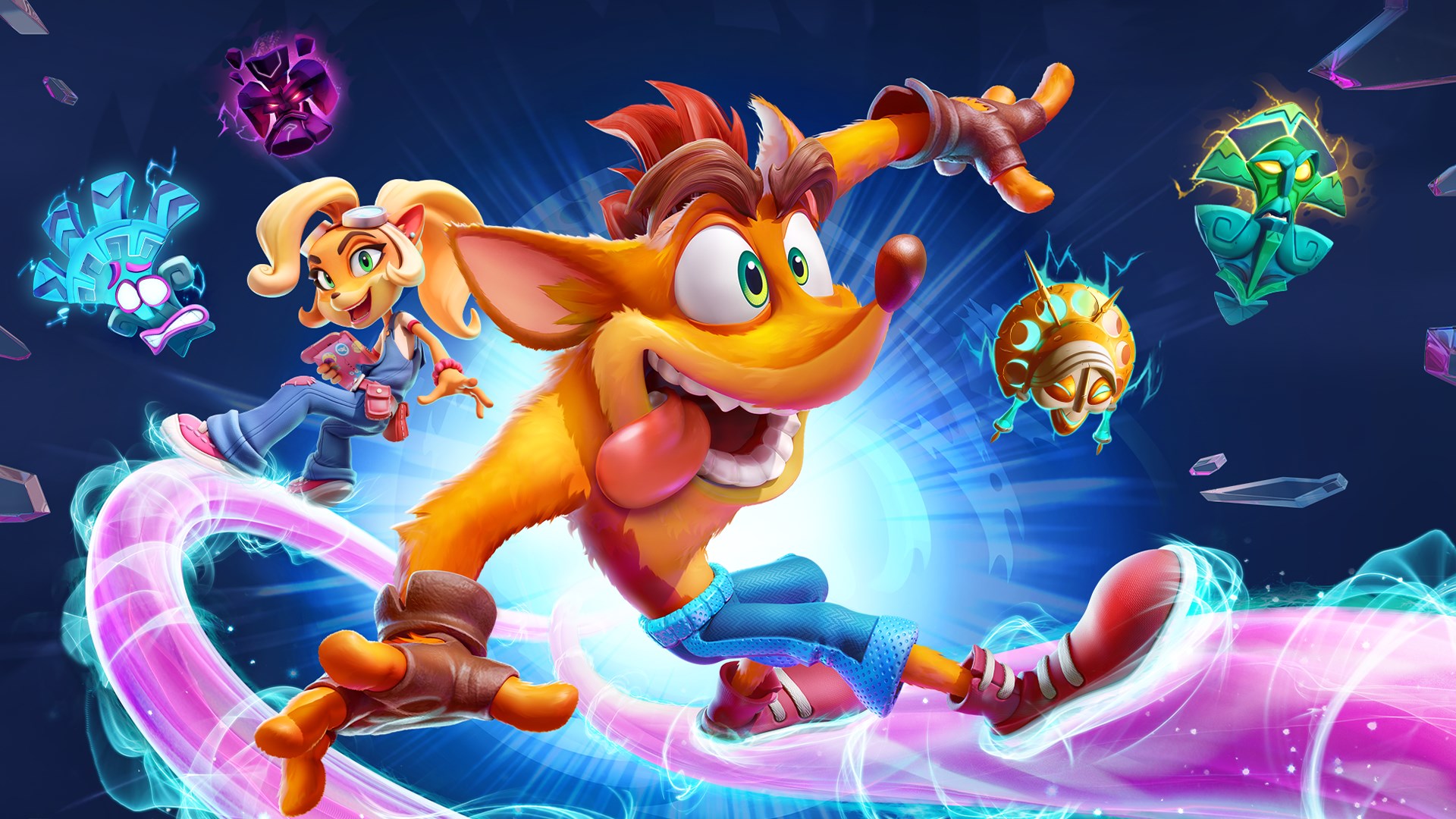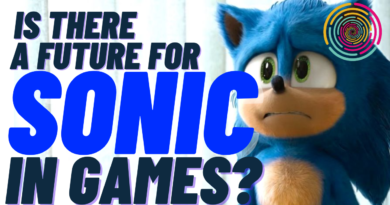Crash Bandicoot 4: It’s About Time (PS4) Review – A Modern-ised Classic
Crash Bandicoot. The staple of every 90s Playstation kid’s game library, and one of Sony’s original mascots is back, in Crash Bandicoot 4: It’s About Time. We see if it earns the right to call itself Crash 4. The Finger Guns review.
Perhaps a more apt title for this review would be, the rise and fall and rise again of Crash Bandicoot.
When I saw the title of Crash Bandicoot 4, my first thought was, right, so we are pretending the last 20 years didn’t happen? There were a lot of Crash Bandicoot games after the original Naughty Dog trilogy; the first Crash 4 was called the Wrath of Cortex, then there was Twinsanity, and Crash of the Titans, and Mind over Mutant, plus about four Gameboy Advance spinoff titles and six different karting titles. This is technically the eighth main series game, so why is it that we are pretending all those games don’t exist. Well, pretty much because they simply weren’t up to standard of the originals. Let’s be honest, not many of us played them. Personally I gave up after playing barely half of Wrath of Cortex, despondent that my favourite Playstation mascot had fallen so low.
But now we have Crash Bandicoot 4: Its About Time, claiming to be the fourth in the series. You could argue that’s just a chronology thing, but I’ll counter with ‘it’s definitely a marketing stunt’. We are being told that this installment is not like the others that have come before, this one is worthy of the name, of the number. It’s a relaunch, along with the N Sane Trilogy a few years ago, a gritty reboot of the franchise, but without the grit. Developed by Toys for Bob, who recently remade the Spyro trilogy, and assisted Vicarious Visions on the aforementioned N Sane Trilogy, it’s got the chops, but is it up to the very high standard set by those Naughty Dog classics?
It’s a tall order – you’ve got a rabid fanbase who are going to crucify anything that makes this claim and doesn’t deliver. It also needs to be modern and appeal to modern gamers, while at the same time maintaining tried and tested gameplay mechanics that we know and love. Think what else has come between, just in platforming alone. Jak and Daxter, Banjo Kazooie, 3D Sonic, more Mario than you can shake a pipe at, and the whole galaxy-hopping franchise of Ratchet and Clank. Crash 4 needs to have learned from all of them, to be able to stand beside them, and yet keep its essential Crashness intact.
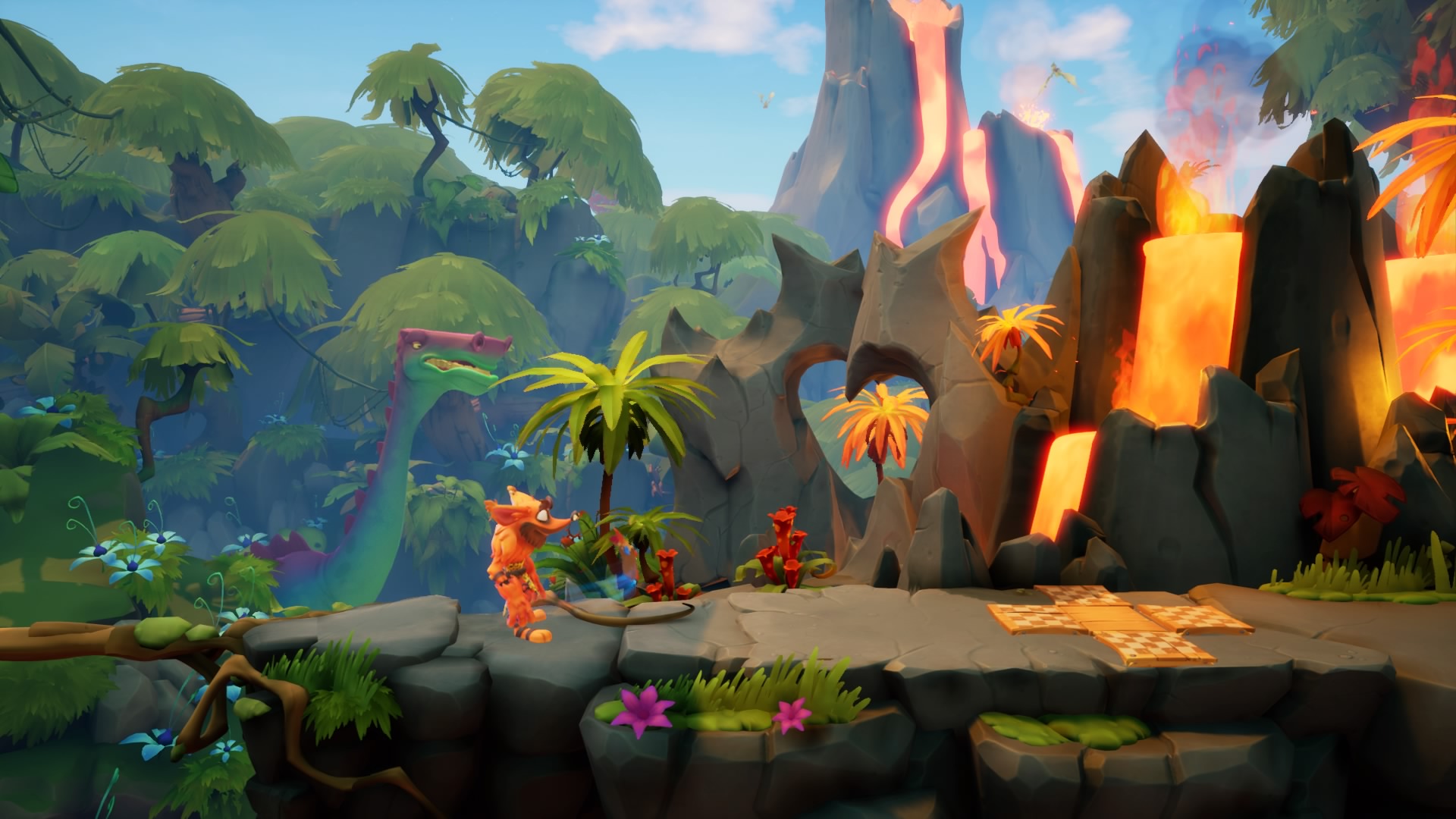
It’ll be xylophone music to your ears then, that the original gameplay you know is indeed intact, but has been revamped with all the modern graphics and mechanics that we have come to expect from 22 years of further video game evolution.
The story does away with the last four titles, setting its events just after those of Warped. The Villains: Uka Uka, Neo Cortex and NTropy, had been sealed away in a prison in the past, but Uka Uka is a magic mask and it’s not long before he opens a quantum rift. The villains escape, although Cortex seems very apathetic to actually committing to a new evil scheme, and N Tropy takes over as the big bad, as he was close to doing in Warped, embarking on a machine that will take advantage of the rift and allow them to conquer every dimension in the multiverse. Little do they know that their actions have awakened the Quantum masks, a group of ancient Witch doctors now sealed in masks.
Aku Aku wakes Crash and when they reach the top of Wumpa Island’s mountain, they find the first of these Quantum masks, called Lani Loli. Lani Loli agrees to help, gifting Crash with the ability to phase shift between realities, and it’s now up to Crash and Coco to travel the rifts in the multiverse, and put an end to N Tropy’s plan once again.
It’s a simple enough story, nothing that you won’t be able to follow and it has a script that’s funny in places. I genuinely laughed out loud at a few of the more tongue-in-cheek references. The bad guys ham up their performances for sure, but it’s all to be expected. Indeed Cortex has been slowly mellowing towards Crash across the different games of the franchise, and here he is quite happy to let N Tropy take the reins.
What’s interesting here is that the new story leans into some of the parts that were only really assumed before, such as Crash and Coco actually being genetically-enhanced experiments of Cortex’s, who escaped after much obstacle course running. It gives this entry a little more basis in a backstory than the other games had. If you thought about the story before, then it was clear every genetically enhanced marsupial in the game was one of Cortex’s experiments, including Crash, but it wasn’t really called out much.
Crash 4 is aware of what it’s doing by calling itself Crash 4. More than one character swears they had met more than three times, or that there had been other adventures, before shrugging and chalking it up to rift and time issues. It’s the type of fourth-wall breaking script that works well for Ratchet and Clank, and there’s probably more story here than there was in any single one of the original trilogy games.
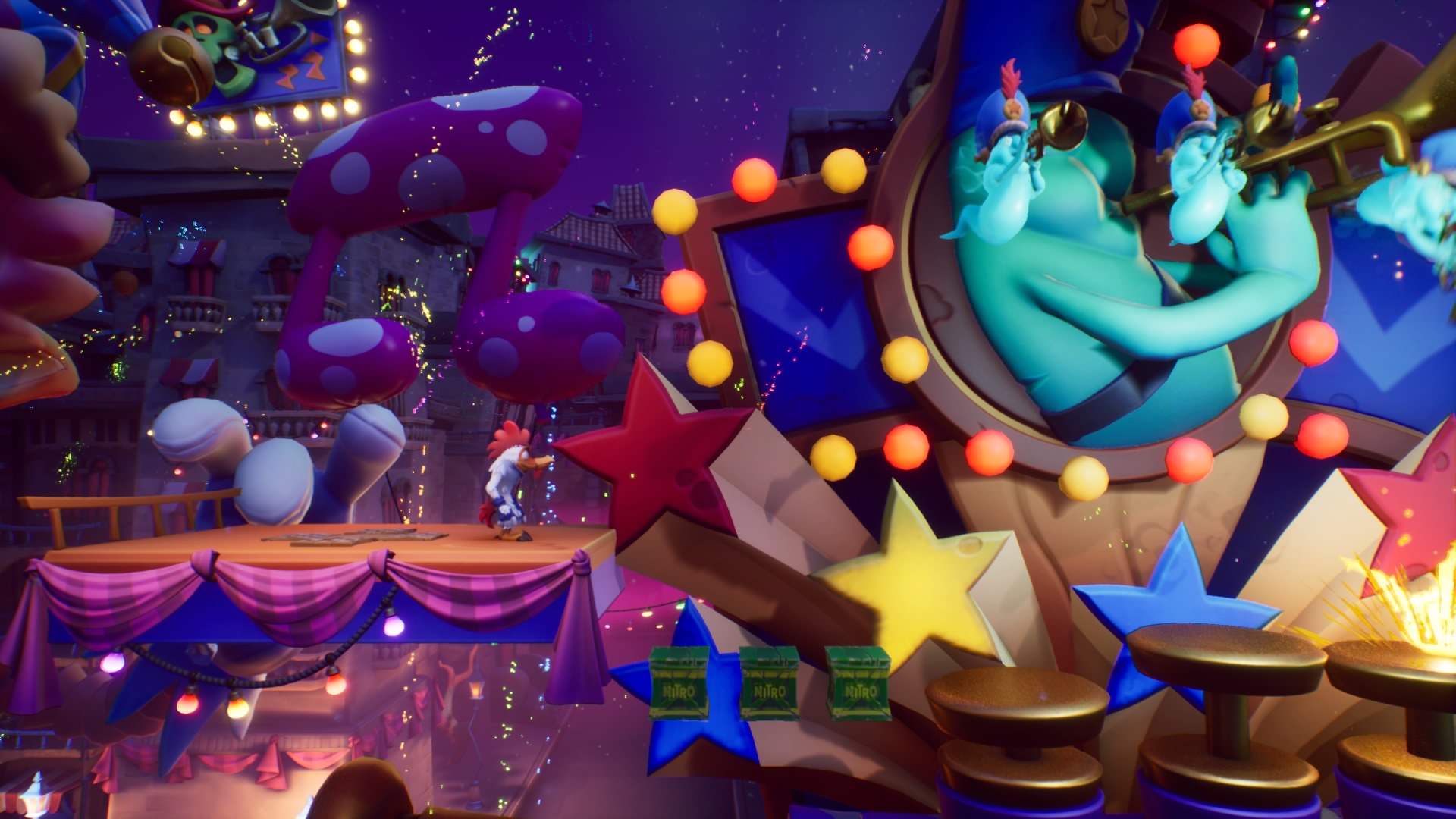
After the introductory two levels on Wumpa Island, the rifts open and we get to see more of the scale of Crash 4. It has a wonderfully animated multiverse level hub, with water moving, tentacles that try to grab you, and all your pre-level setup ready to go, such as skins and what gems you still need to get. Each of the 10 or so hub dimensions has some 4-6 levels and sometimes a boss.
Crash and Coco travel through a number of eras and dimensions in their chase after Cortex and Ntropy. There’s a dystopian future wasteland world, a pirate world, an Icey future world. I personally loved the couple of New Orleans flavoured levels, with Mardi Gras, the bayou, and Dingodile’s Dive/Diner. The medieval Asian-themed world and the prehistoric dinosaur era are both standouts, but without doubt my favourite was the Space-station and Alien worlds towards the end of the game, levels that would have been completely impossible on 90s hardware, and the best any Crash level has ever been. I mean there’s an alien creature to ride, come on!
It’s a big game, more akin to the size of modern platformers like Rayman Origins, than the original games. Crash 1 had about 30 levels, same for Crash 2 and Warped had 35 or so if you include bosses. Crash 4 has 43 story levels, as well as a number of alternate sections for Tawna, Dingodile and Cortex (more on them later) and then 21 special challenging flashback levels you can earn. Each of the 43 story levels also has an NVerted version, which may sound like I’m counting them twice, but the graphical changes, handicaps, and mirrored levels you get in this mode make them almost entirely new. You end up with around 100, which dwarfs its predecessors.
Levels in Crash 4 are also quite a bit longer than they were in the original trilogy, and they come with possibly double the number of checkpoints. Some of the Asian levels are sprawling and will take a long time to get through.
I should call out the Flashback levels here, which are crazy. These require you to get to certain points in story levels without dying in order to earn, and consist of obstacle course-training for Crash and Coco, back in the days when they were lab-bandicoots for Cortex. They are presented like recordings of experiments. Most will be recognisable to Crash players – they are long intricate box bouncing levels, where there is often no floor for screen after screen, and you have to bounce off each and every last box to complete them. Think of them like the B-Sides in Celeste, challenging side missions for those who get really gud. The NVerted levels are fun variants, but the majority come down to mirrored level and a colour palette swap.
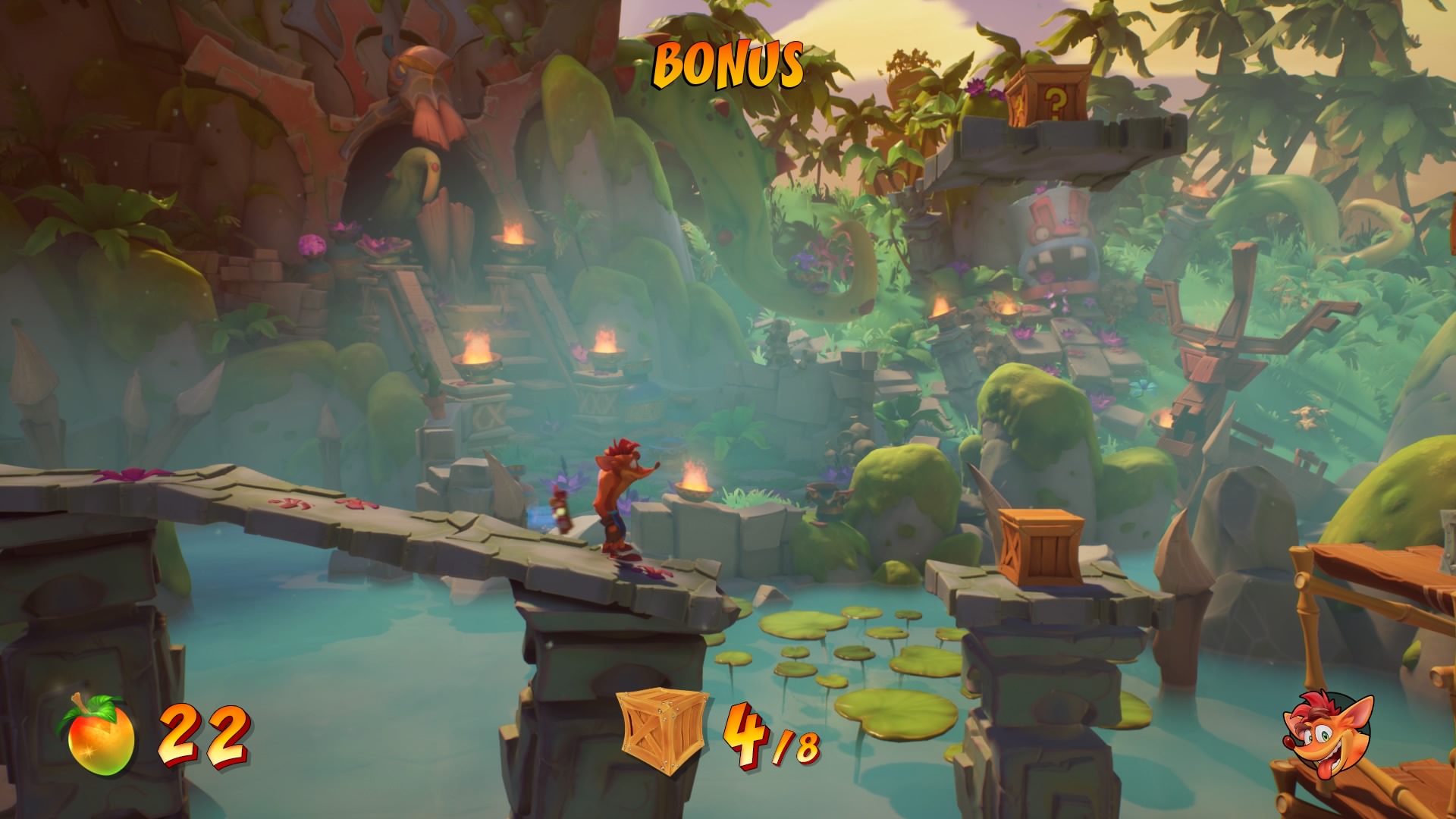
Thankfully, Toys For Bob have not just rehashed all the old things in Warped – they’ve innovated all over the place, modernising a franchise at the same time as creating a sequel.
You can now play every level as either Crash or Coco, giving Coco the real boost she deserved all along. No longer relegated to a few tiger-riding levels, she now shines on her own, and has the same limelight as Crash. At the same time, Crash 4 gives us three more playable characters in Tawna, Dingodile and Cortex, each with their own unique abilities and story levels. Tawna appears first, albeit a Tawna from a different dimension, rather than Crash’s blow-up bimbo from the original game. She’s now a very cool adventurer in her own right, and has a hookshot that has her able to shoot boxes from afar and bound over enemies.
Dingodile has retired after his appearance in Crash 2 and opened a dive café in the bayou. His introductory level has his café burnt to the ground and him chasing after the perps, but there is little explanation why and how he joins our heroes. Dingo has his wonderful vacuum cannon, and can suck and shoot boxes at enemies, but he is a much slower style character. Finally Cortex himself gets a few levels towards the end – I won’t spoil how this happens. Cortex has a raygun and can shoot boxes and enemies and turn them into platforms. All three new playable characters are fun and do much to expand on the experience. Their powers were welcome as I found I missed the Wumpa Launcher from Warped, and each of them has a type of long-range weapon. Once you have earnt them, each of the new characters are playable in a number of alternate levels, showing how they were helping Crash/Coco all along, changing things in levels for when our heroes arrived.
Crash 4 has also borrowed from some of its contemporaries. One welcome new addition is a number of on rails sections that have Crash or Coco sliding and grinding through areas. This mechanic is straight out of Ratchet and Clank, but it’s implemented well, and I don’t see anyone taking issue with it when it’s done this well.
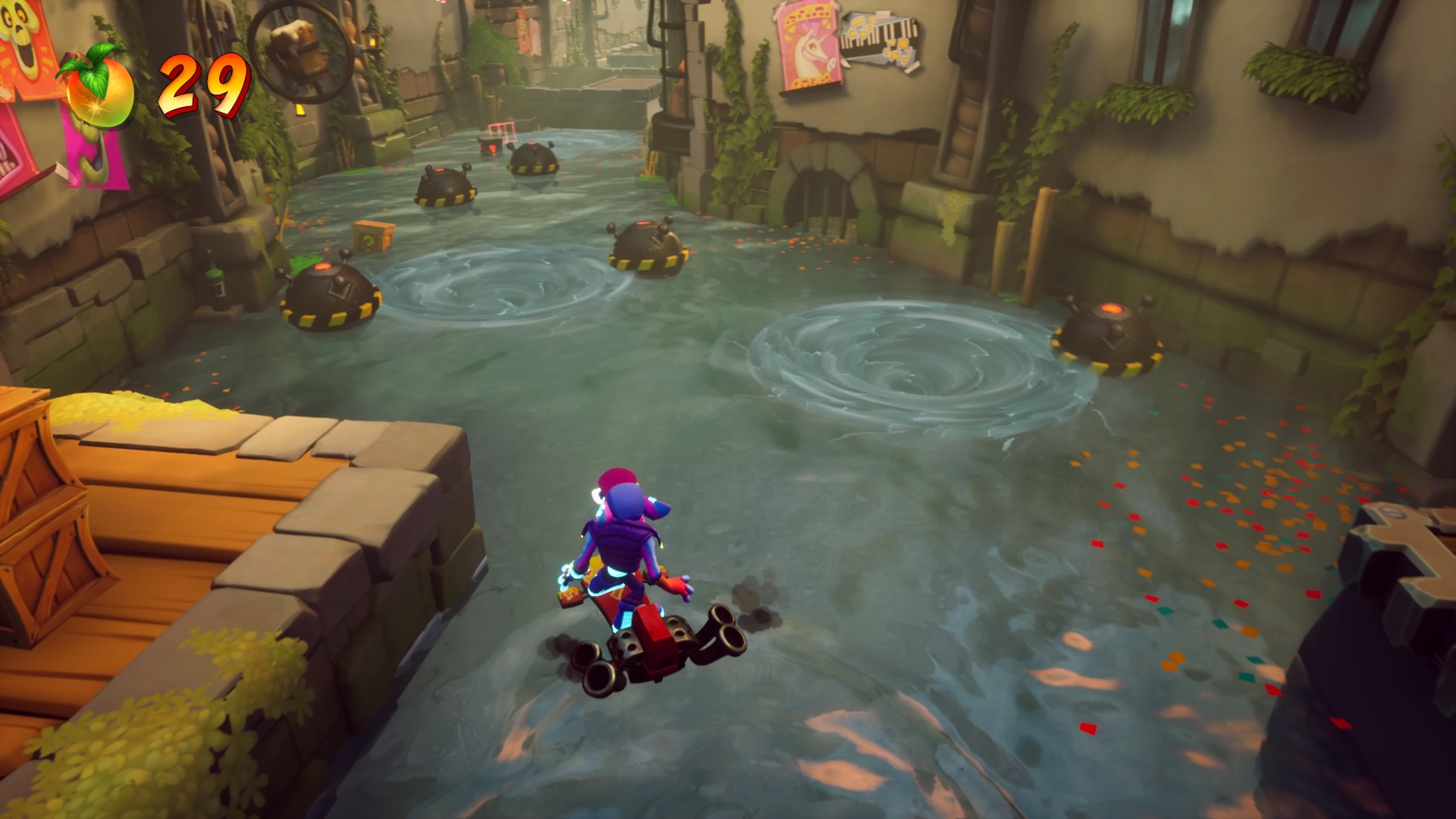
The Quantum masks that you find during your travels bestow upon our heroes 4 new abilities, usually only available for short sections in levels where the mask itself will show up to help out. The first is a kind of phase shift that alternates between two different states for the level – boxes appear or disappear depending on the dimension you are in, and you can switch between them on the fly. This makes for some truly challenging sections when platforms require you to phase shift between jumps in mid air all the way through certain levels.
Second comes a kind of ultra-spin, that gives you added height and air-time, but takes some getting used to. You have to set it off, and then jump while spinning to achieve the air you often need, plus the spin doesn’t stop unless you turn off the power, which instantly drops you. It’s a tough ability, equal parts useful and very difficult to master.
Third comes the power over time itself – a time-pausing mechanic that’ll have you trying to halt falling blocks in mid-air for you to use, or pausing icefloes to run across. Plus nitro can’t hurt you in paused time. And finally fourth comes late in the game during the space-station levels and is control over flipping gravity from floor to ceiling. Cue shenanigans as you must jump and change gravity on the fly. That’s still not the end of the new abilities as there is now wall-running in places, and rope swinging, but clearly there’s just too many to write about in a coherent review.
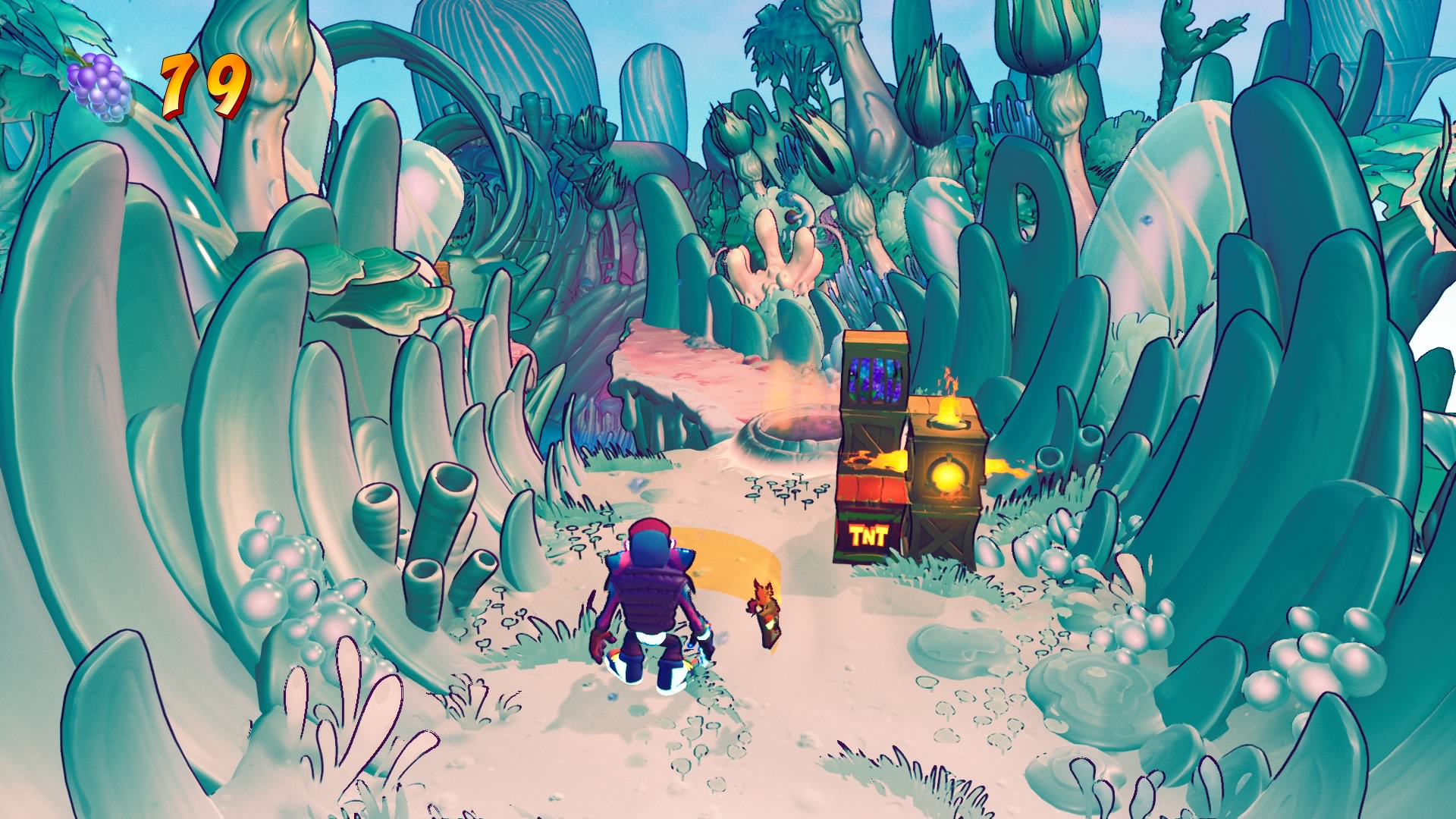
Gem collecting and lives are areas where we also see the most modernisation. Gone are the gem systems of the past, where you would get a gem for all the boxes for example. Instead the new game is bursting with far more opportunities to get gems. It’s a bit like the wonderful Rayman Origins and Legends in that respect. Now you can earn up to three gems for getting all the Wumpa fruit, a gem for all the boxes, a gem for doing the level in three lives or less, and then a secret gem – that’s 6 for each level.
And where before these were simply bragging rights, and looked nice on your memory card save file, now gems equal skins, because who doesn’t like skins these days? I mean if they don’t come attached to microtransactions, that is. Thankfully here, everything can be earned in game, and there are dozens of skins to earn for Crash and Coco. It’s a good modern take on making you want to replay and perfect those levels. I would have taken tying them to trophies, but this is even better.
There is also the opportunity to play the game both modern style and retro style – retro gives you lives and tasks you with completing each level in just those lives or it’s back to the beginning, while modern lets you have infinite tries from each checkpoint, and makes the three-life trial an optional gem challenge. This ‘modern’ style allows the game to be much harder than the originals ever were.
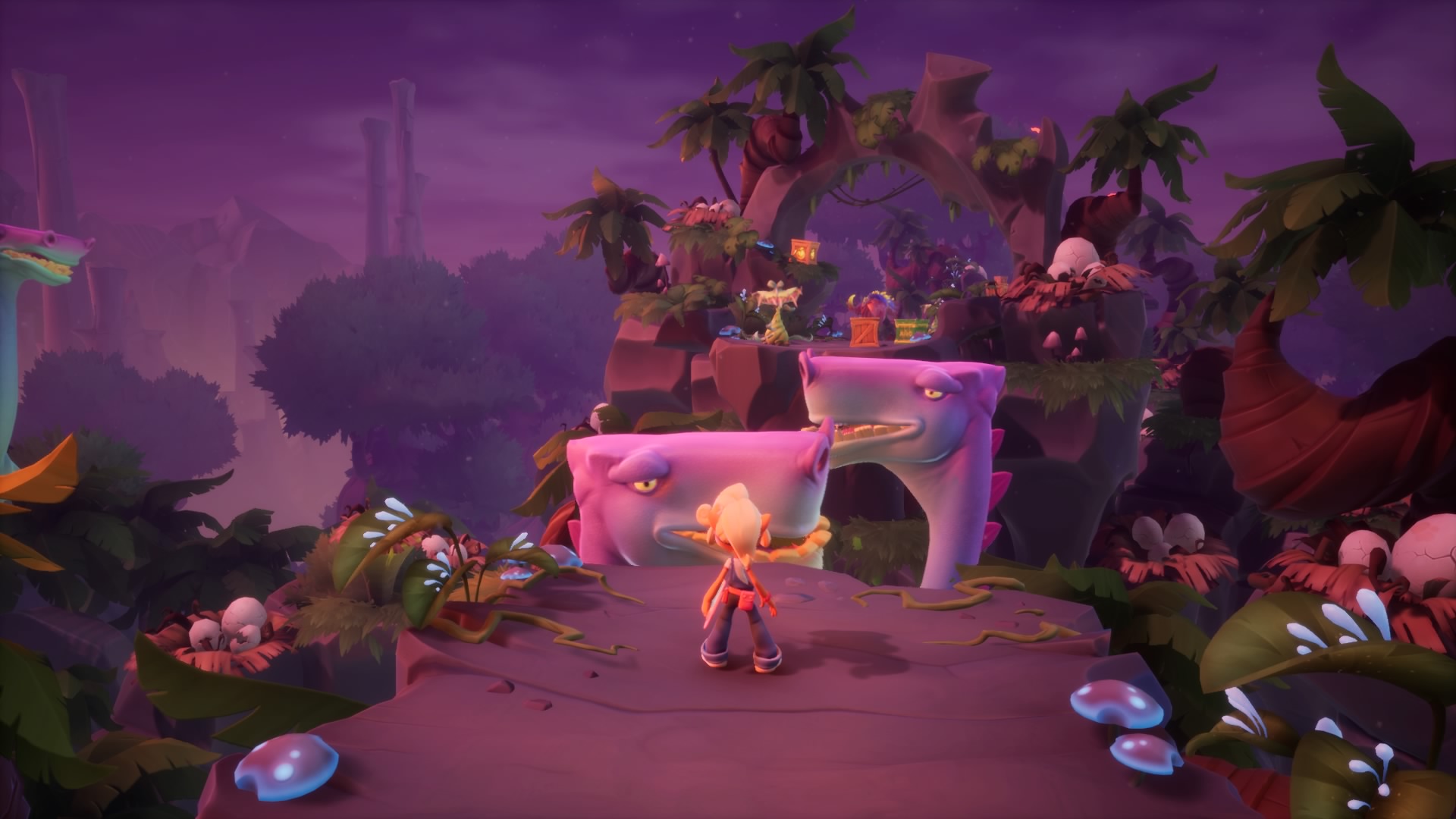
You shouldn’t mess with the things that work, and that’s the tried and tested formula; spinning and bouncing boxes, TNTs, Nitros, checkpoints, Wumpas, double jump. The basics are there and if anything are more responsive than ever. But there are other things that make a welcome return, and there are things wisely left of the cutting room floor. I’m glad there is a 90s level hub – it solidifies the Crashness of everything. I’m glad it’s not been thrown out in favour of an open-world hub like Mario 64. I’m glad nothing open-world has made it into this game. The originals are linear obstacle courses, and Crash 4 nails that. You know where an open-world hub might work? A potential Spyro 4, because Spyro was always a far more 3D and open experience.
Crash’s signature music is back, as catchy as it always was full of xylophone-fuelled, tribal jingles, but all of them new and fresh and different to the originals. I swear if these had been the themes in the originals I’d have hummed these absently for the last 20 years.
I’m also glad that some fan favourite sections get a nod, usually not for long, but as a special level. The Jetboard from Crash 2 returns in the Swamp levels, you can ride the bear during one of the Ice world levels. If there was one thing worth keeping from Wrath of Cortex (which let’s face it wasn’t much), it was the ball levels, and there is one section where this make a welcome, albeit brief return.
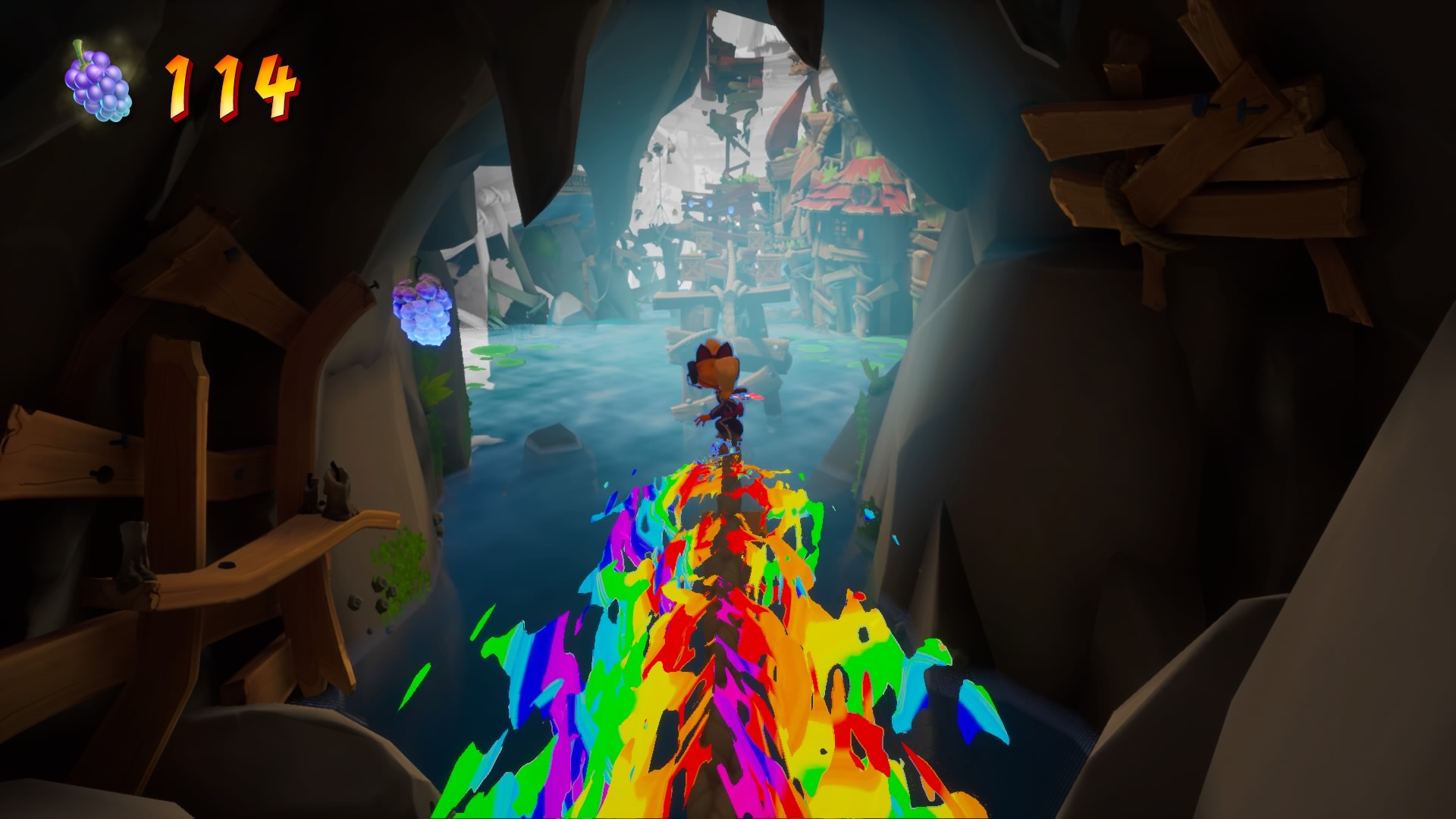
But there are also things that don’t return; there’s no Wumpa Bazooka, that overpowered toy from Warped that made getting hard to reach boxes far too easy; there are no vehicle levels, at least not of the type popularised in Warped like the dogfighting plane levels and the motorbike races; plus I’m sad to say there are no underwater swimming levels. Perhaps it could be argued that we’d rightfully had enough of these things, and that half the reason the other subsequent games failed, was that they kept too much of what Naughty Dog had done and didn’t do enough that was new. That balance isn’t easy, as four failed games can attest.
One issue that really started to mount up after a while playing was the large load times. We expect maybe a minute to load large games and then get stuck in for hours. However in Crash 4 every level is a separate loading screen, as you might expect in a platformer. But with a minute or so load times on each and every level, the time really starts to add up and become a detriment. I’m glad to say, dying and resetting takes no time at all.
Crash 4 modernises in one more way – towards the trend for games to be harder. Even a couple of worlds in, the levels start to get exceptionally difficult, and if you want all the boxes, nigh on impossible. A full run at all the gems, time trials etc, could have this last anyone months and months, and for most it will be an impossible task. While at the start it can seem like getting the full 6 gems on each level might seem simple, you then hit a difficulty spike as soon as quantum mask powers are introduced.
The requirement to get all the boxes, and the sheer finger gymnastics that must be achieved over and over again to get them and keep them to the next checkpoint, starts to feel very difficult indeed. After dealing with NBrio, you earn NVerted mode, and suddenly its possibly to get twelve gems per level, and getting six becomes a lot more doable. The game does recognise that it’s harder, and sometimes gives you extra checkpoints, and in the bosses you rarely need to do more than a stage or so in one life, but on the whole, players will notice the spike. What’s sad about this is that those enticed back to gaming by the promise of more Crash Bandicoot may find themselves left behind by the leaps and bounds the rest of us have taken to get gud.
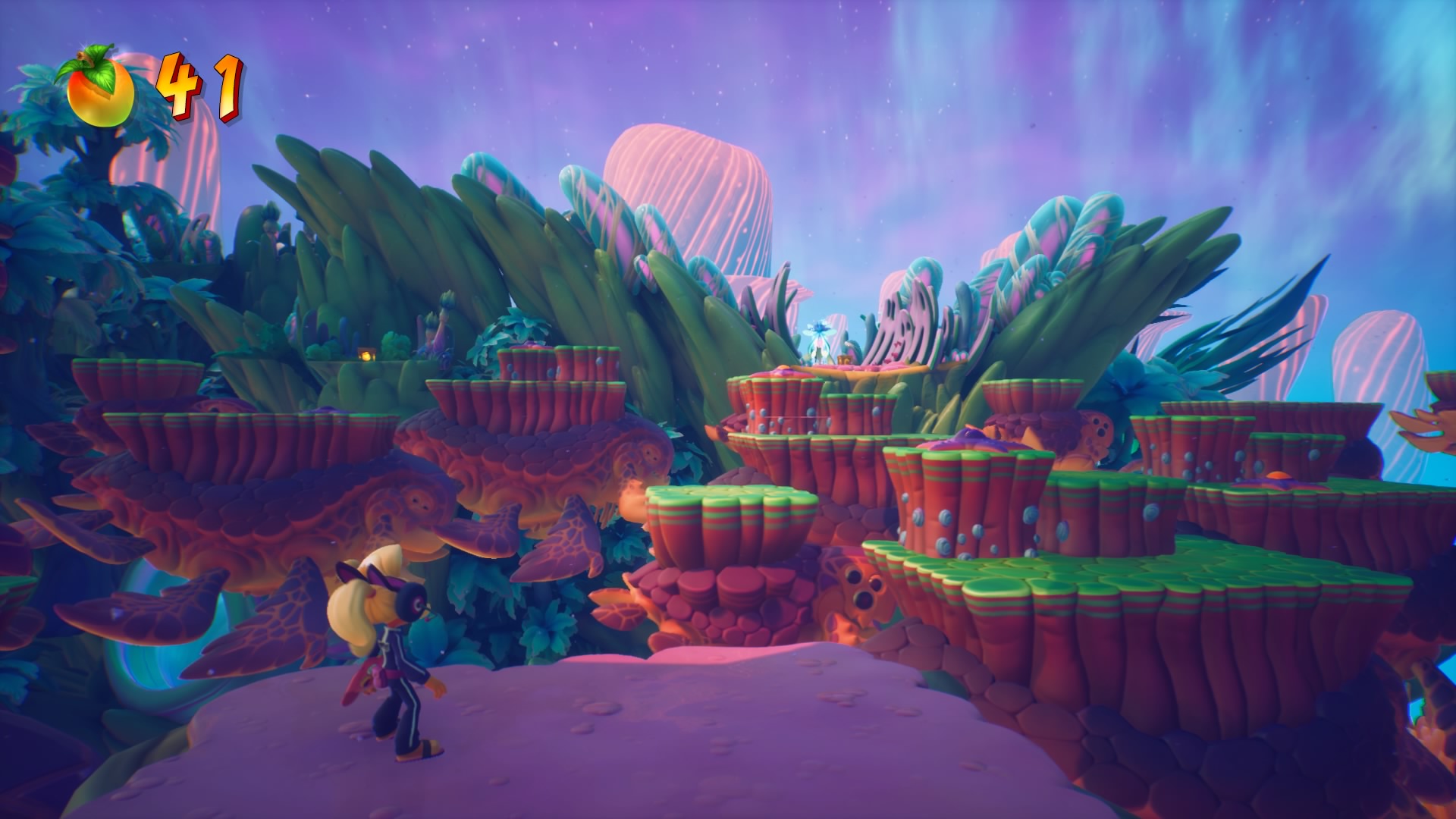
Crash Bandicoot 4: It’s About Time is a worthy sequel to a classic series. There’s clear method in washing away the games that came before it, both in terms of rebooting the plot, and in the marketing claim that this is the true sequel. The promise is inherent in the title, this is a continuation of the quality of the original games, and its a promise that Toys For Bob have delivered on.
While staying true to core mechanics and beloved gameplay, Crash 4 manages to do that which other games failed to do – introduce new ideas that work, modernise where necessary and don’t rest on past glory. The additions of new playable characters, Coco throughout, new abilities and mechanics that feel at home in the franchise, are all testament to it working this time around.
And there’s clear love for Crash Bandicoot 2, rather than Warped. Far more has survived from Crash’s second outing than his third, but what has stayed is the essentials, the fan favourites. What’s been cut is the chaff. Crash 4 shows exactly how to modernise a classic, and create a modern classic at the same time.
Crash Bandicoot 4: It’s About Time is the perfect distillation of classic gameplay, and modern gaming demands. It is full to bursting with content, things to earn and masses of replayability. Though its difficulty may be too high for some, it’s definitely the best Crash Bandicoot has ever been and deserves its place alongside the original trilogy. A classic modernised and a modern classic.

Crash Bandicoot 4: It’s About Time is available now on PS4 (review platform) and Xbox One.
Developer: Toys For Bob
Publisher: Activision
Disclaimer: In order to complete this review, we were provided with a promotional copy of the game. For our full review policy, please go here.
If you enjoyed this article or any more of our content, please consider our Patreon.
Make sure to follow Finger Guns on our social channels –Twitter, Facebook, Twitch, Spotify or Apple Podcasts – to keep up to date on our news, reviews and features.
